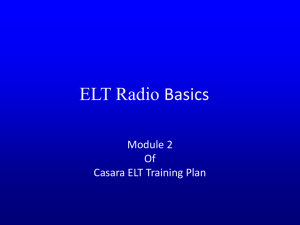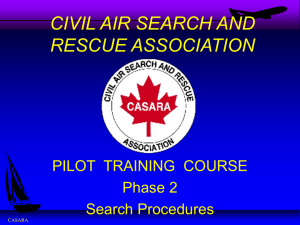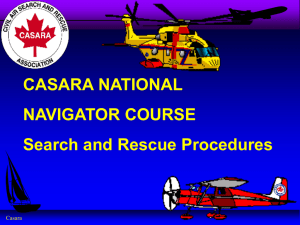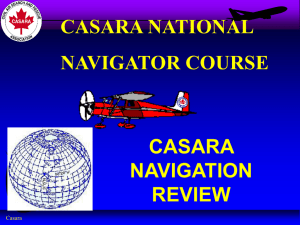Module-7-First-on-Scene-Management-v3
advertisement
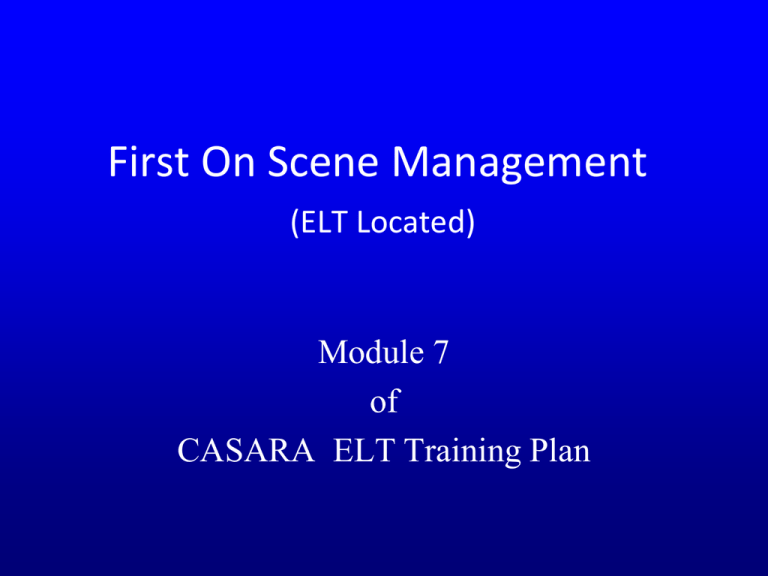
First On Scene Management (ELT Located) Module 7 of CASARA ELT Training Plan CASARA Members Please Note • CASARA’s task is to locate the source of the ELT signal. • CASARA members do not have any authority to enter any aircraft or building, locked or unlocked, without the owners permission. • If CASARA members need to enter an aircraft or building we contact JRCC and they will notify the local authorities who will obtain access to the aircraft or building. • Regarding placing anything over an ELT antenna, CASARA members do not have any authority to do this. • Placing anything over an antenna while it is transmitting may damage the ELT. • You could be held liable. ELT Located Non-Distress Situation ELT Located Non-Distress Situation Contact JRCC Assistance of the local law enforcement or airport manager should be obtained to locate the owner or to gain access to the ELT. JRCC task would be to provide the authorities to shut the ELT down if unable to locate the owner. CASARA has no special entry authority in non-distress situations. ELT Deactivated • Report to JRCC when ELT deactivated, aircraft registration and time of ELT deactivation. • Leave a note if owner was not present and the ELT was deactivated by aircraft maintenance personnel. • REMEMBER CASARA does not have special authority to enter aircraft to deactivate an ELT. ELT Located Rescue Situation Ground Note; • JRCC are unlikely to knowingly send a CASARA ground team to a crash site as first responders. • However, there may be circumstances where a CASARA ground homing team may, due to lack of valid information, be involved as First on Scene responders to a crash site. • Precautions should be followed to protect the victims and those responders approaching the crash site. ELT Located Rescue Situation Ground Refer also to the following document on the CASARA National website; First on the Scene . . . EMERGENCY SCENE MANAGEMENT: Basic Guidelines for CASARA Ground Homing Teams C. A. Smith • • • • • • • • ON SCENE Protocol CASARA Handbook p 7.9 Crew prioritizes their initial actions. Confirm roles and responsibilities. Contact JRCC First. Contact 911 then inform Searchmaster. Report GPS location. Call out and identify yourself as you approach the aircraft advising that you are on your way, to stay calm and do not move. Listen for a response. ELT Located Rescue Situation Ground Approach with Caution • Assess the situation. • Is your safety in danger? • Are there overhanging objects? -Aircraft debris, branches etc. • Fuel or oil spills around aircraft ? • Aircraft structure unstable ? • Is aircraft secure for rescue ? - on a ledge, steep slope , in trees ELT Located Rescue Situation Ground Potential Hazards • Fire and smoke. • Jagged metals and plastic? • Carbon fibers from composite (similar health risk as asbestos fibers)? • Pressurized gas cylinders (“halon” fire extinguisher, oxygen bottles? • Seatbelt Airbag System in aircraft? • Is aircraft equipped with Ballistic Parachute System ? • Spilled or leaking fuel, hydraulic oil, battery acid? • Spilled hazardous material from cargo ? • Live wires from severed power lines? • Military aircraft hazards - ammunition, ejection seat system, flares, oxygen? • Biological hazards? Wear Gloves to protect yourself and the patients. ELT Located Rescue Situation Ground Occupants Occupant(s) in danger? • Electrical power still on ? Check master switch. • Fuel off? Check fuel valve switch. • Hanging in seat by seatbelts ? Would releasing seatbelt cause more injury to occupant or would it be better to leave in seat (check surroundings for sharp objects, legs and arms that may be jammed in aircraft). • Who has FIRST AID TRAINING? • If patient is conscious.Let patient know who you are. • ASK questions such as; – – – – – – – – Their name, next of kin Medical history Medications - prescriptions Where does it hurt Allergies Last time they ate Incident history How many occupants and if everyone is accounted for • Reassure occupants that rescue is arriving and provide treatment to your level of limits and provide comfort (protection from elements). • Occupants should not be moved unless there is an immediate threat to life. • Never let occupants (walking wounded) leave scene on their own to go to rescue vehicle. Rescue Situation ELT Located ELT Located Rescue Situation-SAR Resource • Leave ELT ON. • Establish if SAR resource is needed (Occupant is injured). • Aid SARTEC by providing info. • Look for clearing nearby and advise if you see any hazards such as wires, tree stumps, rocks hidden by deep grass. • Prepare area for rescue. • Marking path to site for ground rescue team. ELT Located Rescue Situation-SAR Resource • Selecting site for possible helicopter operation (look for clearing nearby and advise if you see any hazards such as wires, tree stumps, rocks hidden by deep grass. • Be aware of helicopter downwash if landing nearby or lowering SARTECs into site (secure or remove loose objects near area). ELT Located Rescue Situation-Hand off • Secure area until authorities are on scene. • Authorities will assume command and control on arrival. • Provide information to those arriving on scene. • Prepare notes for briefing giving details of what was done up to the authorities arrival. • All reports should be done in pen for legal purposes. Are there any questions? CASARA “THAT OTHERS MAY LIVE” THANK YOU

